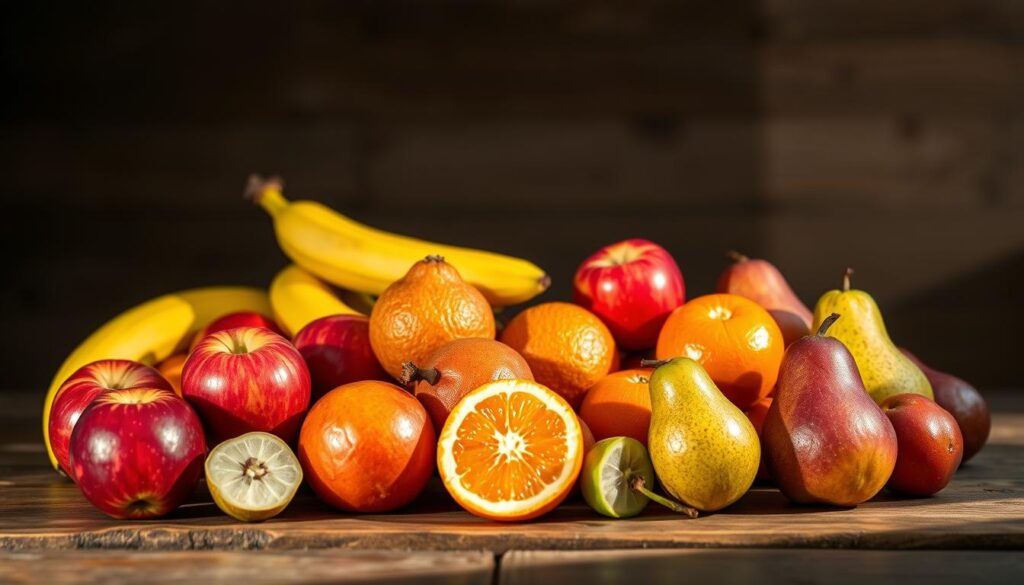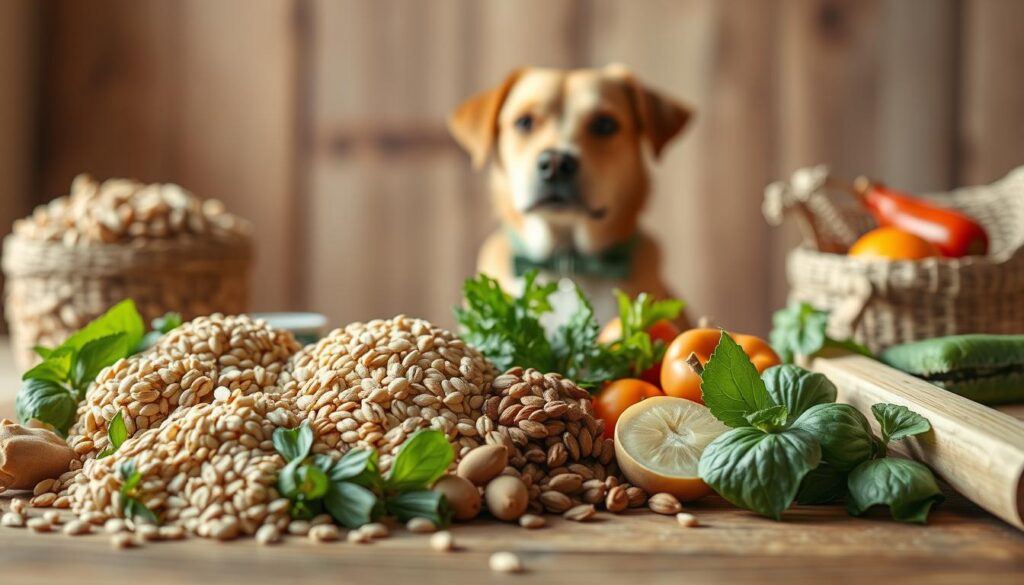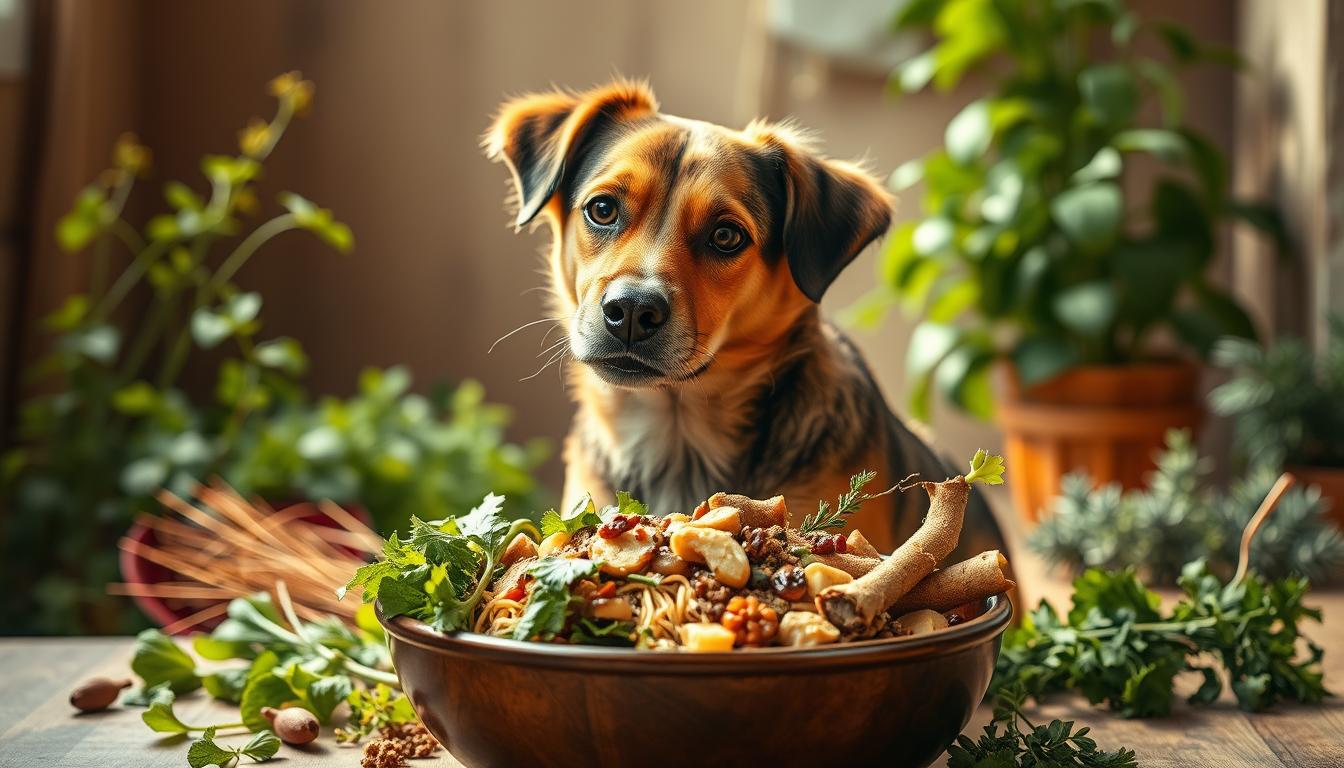Roughage for Dogs: The Secret to a Healthier, Happier Pup
Table of Contents
Every dog owner knows the pain of seeing their pet struggle with digestive issues. I remember my rescue dog Max fighting constant stomach problems. But then, I found out about the amazing benefits of roughage for dogs.
Proper fiber intake can change your dog’s health for the better. It can turn uncomfortable digestive problems into smooth, easy days.
Roughage for dogs is more than just a trend. It’s a key part of their nutrition. Their digestive system needs fiber to stay healthy, have regular bowel movements, and feel well overall. Whether your dog is young or old, knowing about dog roughage can greatly improve their life.
This guide will teach you all about adding the right fiber to your dog’s diet. You’ll learn about the science of digestive health and the best natural fiber sources. You’ll discover how to keep your dog feeling their best.
Key Takeaways
- Fiber is essential for your dog’s digestive health
- Different types of roughage serve unique nutritional purposes
- Natural fiber sources can improve overall canine wellness
- Proper fiber intake supports healthy weight management
- Gradual introduction of fiber prevents digestive upset
Understanding Fiber’s Role in Canine Health
Dietary fiber is key for your dog’s digestive health. It comes from plants and is special for your dog’s health.
Dogs need both kinds of fiber to stay healthy. Knowing about these fibers helps you choose the best food for your dog.
The Science Behind Digestive Health
Fiber is vital in your dog’s diet. It helps with bowel movements, keeps gut bacteria healthy, and helps with weight management.
- Supports regular digestive processes
- Helps maintain healthy stool consistency
- Provides essential nutritional support
Soluble vs. Insoluble Fiber Benefits
| Fiber Type | Key Characteristics | Primary Benefits |
|---|---|---|
| Soluble Fiber | Dissolves in water | Supports blood sugar regulation |
| Insoluble Fiber | Does not dissolve in water | Promotes digestive tract movement |
Impact on Gut Microbiome
Your dog’s gut microbiome needs fiber to thrive. Beneficial bacteria use fiber for energy, keeping the gut healthy.
Choosing the right fiber sources helps your dog’s digestive health and overall well-being.
Essential Benefits of Roughage for Dogs
A high fiber dog diet is key for your pet’s health. It offers many benefits beyond just digestion. It helps keep your dog’s gut healthy and supports their overall well-being.
Fiber brings several important benefits for dogs:
- Helps with weight management by making them feel full
- Keeps blood sugar levels stable and improves insulin use
- Prevents constipation and keeps bowel movements regular
- Reduces the risk of some digestive diseases
Adding fiber to your dog’s diet can greatly improve their digestion. It helps their body absorb water and makes their stools firmer. This makes it harder for bad bacteria to grow.
Dogs eating enough fiber often have better anal gland health and less inflammation. The fiber helps clean their digestive system. This supports their internal health and promotes a healthy gut.
Veterinarians suggest adding fiber slowly to avoid digestive problems and ensure they absorb nutrients well.
Knowing and using these fiber benefits can help your dog have a strong and healthy digestive system all their life.
Types of Dietary Fiber Your Dog Needs
Knowing the best fiber for your dog’s digestion is key to their health. Fiber is crucial for a healthy digestive system. There are two main types, each with its own benefits.
Dogs need a mix of fiber types for good health. Soluble and insoluble fibers work together for the best digestive health.
Soluble Fiber Sources
Soluble fiber aids in digestion by:
- Regulating blood sugar levels
- Supporting beneficial gut bacteria
- Helping with weight management
Great sources of soluble fiber include:
- Pumpkin
- Apples (without seeds)
- Oats
- Beans
Insoluble Fiber Sources
Insoluble fiber is vital for digestion. It helps with:
- Promoting regular bowel movements
- Preventing constipation
- Cleaning the digestive tract
Top insoluble fiber sources are:
- Wheat bran
- Vegetables
- Whole grains
- Potato skins
Optimal Fiber Balance
Finding the right fiber balance is crucial for your dog’s health. Not all dogs need the same amount of fiber.
“Fiber is like a nutritional Swiss Army knife for your dog’s digestive system” – Veterinary Nutrition Experts
| Fiber Type | Key Benefits | Recommended Percentage |
|---|---|---|
| Soluble Fiber | Supports gut bacteria | 2-4% |
| Insoluble Fiber | Promotes digestive movement | 3-5% |
Always talk to your vet to find the right fiber for your dog.
Natural Sources of Fiber for Canines
Boosting your dog’s fiber intake is easy. Natural dog fiber supplements can make a big difference with simple, healthy ingredients. Knowing which foods are good for fiber can help your dog’s digestion and health.
Dogs need different natural fiber sources that are tasty and good for them. The goal is to find the right mix that helps their digestive system.
- Pumpkin puree (fresh or canned)
- Cooked sweet potatoes
- Green beans
- Carrots
- Apples (without seeds)
- Blueberries
Start with small amounts of natural dog fiber supplements. Moderation is crucial to avoid stomach problems. Try to make fiber-rich foods about 10% of your dog’s diet.
“The right fiber can transform your dog’s digestive health from the inside out.” – Veterinary Nutrition Experts
Raw or lightly steamed veggies are best for most dogs. Don’t add seasonings or oils that can upset their stomach. Always talk to your vet before changing your dog’s diet, especially if they have health issues.
Safe Vegetables as Fiber Sources
Adding vegetables to your dog’s food is a great way to give them essential roughage. These natural foods are good for their digestive health and make meals more interesting.
Not all vegetables are good for dogs. Some are better than others because they have lots of fiber and other nutrients.
Pumpkin and Sweet Potatoes: Fiber Powerhouses
Pumpkin and sweet potatoes are top picks for adding fiber to your dog’s diet. They have many benefits:
- High in soluble fiber
- Supports healthy digestion
- Helps regulate bowel movements
- Low in calories
Green Beans and Carrots: Crunchy Fiber Options
Green beans and carrots are also great for adding fiber. They are tasty and nutritious.
| Vegetable | Fiber Content | Additional Benefits |
|---|---|---|
| Pumpkin | High | Supports weight management |
| Sweet Potatoes | Medium | Rich in vitamins |
| Green Beans | Low-Medium | Low-calorie option |
| Carrots | Low | Promotes dental health |
Preparation Methods
Here’s how to prepare vegetables for your dog:
- Steam or boil to make them easier to digest
- Chop into small pieces
- Start with a little bit
- Watch how your dog reacts
Always talk to your vet before changing your dog’s diet, especially adding new fiber sources.
Fruit Options for Fiber Supplementation

Fruits can be a tasty and healthy part of your dog’s diet. Not all fruits are good for dogs, but some are great. They offer fiber and other health benefits.
Apples are a great choice for dogs. Rich in pectin, they help with digestion and weight management. But, make sure to remove the seeds and core first. They can be dangerous.
- Blueberries: Packed with antioxidants and fiber
- Strawberries: Low-calorie fiber source with vitamin C
- Bananas: High in potassium and dietary fiber
It’s important to control how much fruit your dog eats. Vets say fruits should not make up more than 10% of their daily calories. Start with small amounts to avoid stomach problems.
“Moderation is key when feeding fruits to dogs” – Canine Nutrition Experts
Some fruits, like grapes and cherries, are bad for dogs. Always check with your vet before changing your dog’s diet.
Whole Grains and Seeds for Dog Nutrition
Adding whole grains and seeds to your dog’s diet can greatly improve their nutrition. These foods are packed with fiber, vitamins, and minerals. They help keep your dog healthy and support their digestive system.
Whole grains are a great way to add natural fiber to your dog’s meals. They help with digestion, keep your dog at a healthy weight, and give them energy.
Brown Rice: A Nutritional Powerhouse
Brown rice is a top choice for a high fiber dog diet. It’s full of:
- Rich in dietary fiber
- Contains essential minerals
- Supports digestive health
- Easy to digest for most dogs
Flaxseed: Omega-3 Packed Nutrition
Flaxseed is great for dogs, offering fiber and omega-3 fatty acids. Make sure to use ground flaxseed for better nutrient absorption.
| Whole Grain/Seed | Fiber Content | Additional Benefits |
|---|---|---|
| Brown Rice | 2.7g per 1/2 cup | Supports digestive health |
| Flaxseed | 3.8g per 2 tablespoons | Omega-3 fatty acids |
Proper Portion Guidelines
Start with small amounts when adding whole grains and seeds to your dog’s diet. Grains should make up about 10% of their food. Always check with your vet to find the right amount for your dog.
Signs Your Dog Needs More Fiber
Knowing about your dog’s digestive health is key to their happiness. Spotting signs that your dog needs more fiber can stop health problems. It also makes their life better.
Dogs show clear signs when they need more fiber. Look out for these important signs:
- Irregular Bowel Movements: Constipation or odd stool quality means they need more fiber
- Frequent Anal Gland Problems: Trouble with anal glands shows they lack enough fiber
- Unexpected Weight Gain: Not enough fiber can make it hard to manage weight
- Persistent Hunger: Your dog might still be hungry even after eating
Digestive health is vital for your dog’s well-being. The right fiber helps with digestion, nutrient absorption, and a healthy gut.
Watch your dog’s energy and bathroom habits. Less activity or hard bowel movements mean they need more fiber. Talking to your vet can find the best fiber for your dog.
Remember, each dog is unique, and dietary changes should always be made under professional guidance.
Proper Fiber Introduction Methods
Improving your dog’s gut health means introducing new fiber sources carefully. Changing their diet can be challenging. It’s important to know the right way to do it for their digestive health.

Dogs have sensitive stomachs that need slow changes. Quick diet changes can cause problems and health issues.
Gradual Integration Strategies
Here are key steps for introducing fiber to your dog’s diet:
- Start with small amounts of new fiber sources
- Increase fiber slowly over 1-2 weeks
- Mix new ingredients with their current food
- Be careful with portion sizes
Monitoring Your Dog’s Response
Keep an eye on how your dog reacts to diet changes. Look for these signs of good fiber integration:
- Consistent stool quality
- Normal energy levels
- No digestive discomfort
- Maintained appetite
If your dog shows negative signs, cut back on the new fiber or talk to your vet. Every dog is different, so a tailored approach is best for their gut health.
Common Mistakes to Avoid When Adding Fiber
Adding natural dog fiber supplements needs careful thought. Many pet owners make mistakes that harm their dog’s digestive health. Knowing these mistakes helps ensure your dog gets the best nutrition.
The most common mistakes when adding fiber to your dog’s diet include:
- Introducing too much fiber too quickly
- Using inappropriate fiber sources
- Neglecting proper hydration
- Failing to monitor your dog’s response
Sudden fiber increases can upset your dog’s stomach. They might feel uncomfortable with:
- Excessive gas
- Loose stools
- Bloating
- Abdominal discomfort
Start with small amounts of natural dog fiber supplements. Slowly add more while watching your dog closely. Talking to a vet can give you advice that fits your dog’s needs.
| Fiber Mistake | Potential Consequence | Recommended Action |
|---|---|---|
| Rapid Fiber Introduction | Digestive Upset | Gradual Integration |
| Incorrect Fiber Type | Nutrient Malabsorption | Veterinary Consultation |
| Insufficient Water | Constipation | Increase Water Intake |
Every dog is different when it comes to food changes. Be patient and watch your dog closely when adding fiber supplements.
Special Considerations for Senior Dogs
As your furry friend gets older, their diet needs change a lot. Roughage is key for senior pets to handle health issues that come with age.
Senior dogs face digestive changes that make fiber very important. Their metabolism slows, and they’re more likely to have:
- Constipation
- Weight management issues
- Reduced nutrient absorption
Fiber is vital for your aging dog’s digestive health. Choosing the right roughage can help with bowel movements, weight control, and gut health. Vets suggest special diets for senior dogs.
When adding roughage to a senior dog’s diet, consider these tips:
- Get advice from your vet on what’s best for your dog
- Pick fiber sources that are easy to digest
- Keep an eye on portion sizes and weight
- Watch for any signs of digestive issues
Good fiber options for senior dogs include:
- Pumpkin
- Steamed veggies
- Senior dog foods with fiber
- Cooked sweet potatoes
“Proper nutrition is the key to supporting your senior dog’s health and quality of life.” – Veterinary Nutrition Experts
Every senior dog is different. Regular vet visits and tailored diets are crucial. They help your aging friend live their best years.
Conclusion
Knowing about canine fiber sources is key for your dog’s health. Dietary fiber helps with digestion, weight management, and supports older pets. It’s vital for their overall well-being.
Adding fiber to your dog’s diet should be done with care. Every dog is different, so talking to your vet is best. They can help you find the right amount of fiber for your pet.
Learning about dog nutrition is an ongoing process. New studies show how fiber can improve your dog’s life. By keeping up with research and listening to your pet’s needs, you can give them the best nutrition.
But fiber is just one part of a balanced diet. A complete diet, vet visits, and knowing about fiber sources make your dog happy and healthy.
There are no reviews yet. Be the first one to write one.


